|
|
|
|
Products mentioned in this Article
--None--
|
|
|
|
|
|
|
|
|
 |
|
|
Infantry Weapons of British Empire in WWII
Rifles
At the outbreak of the Second World War the British Soldier was still armed with the excellent SMLE (Short, Magazine, Lee-Enfield) rifle, a rifle developed from the Lee-Metford and first going into production in 1907. It was used during the First World War by British and Commonwealth troops along side the Canadian Ross, Japanese Arisaka and US made P14 rifles.
|
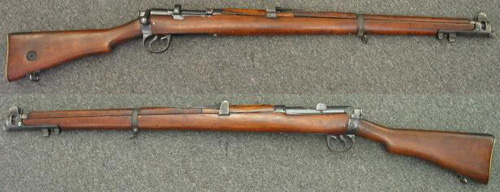 |
The SMLE (or No. 1, Mk III as it was under 1926
designations) was the Rifle used by the BEF in France in 1940, and in
Greece, Crete and North Africa.
The SMLE continued to be made at the BSA Factory until 1943, as well as in Australia (Lithgow) and India (Ishapur).
|
|
The evacuation of Dunkirk led to a massive loss
of equipment and among it was more than a quarter of a million .303
calibre rifles (mostly SMLEs), and a new rifle was rushed into
production at two newly constructed factories (Fazakerley and Maltby).
The new rifle had been in development and trials
since the 1920s, initially starting life as a modification of the SMLE
as the Rifle, No. 1 Mk IV it was redesignated the Rifle, No. 4, Mk I in
1931.
|
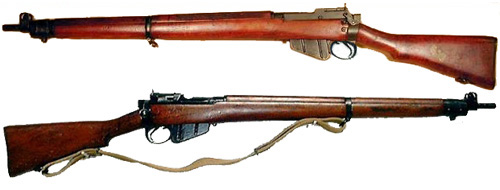
No.4, Mk 1 Rifle
|
|
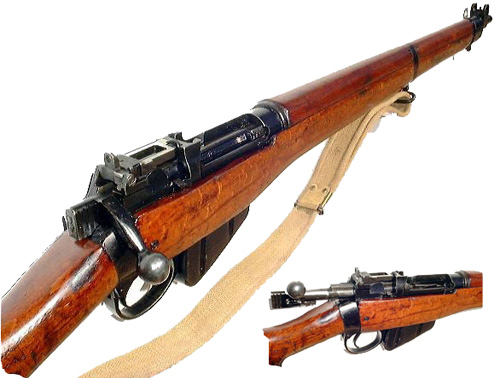
|
They were approved for production in 1941 and during the war 2,021,913
were made in Britain, 330,000 (plus 575,731 for the Canadian and New
Zealand armies) in Canada, and 1,196,706 at the Savage Arms factory in
the USA. The first No. 4 rifles were issued to the troops in Spring 1942.
Left: A close-up of the breach.
Light Machine-guns
The principle Light Machine-gun of the British during the Second World War was the Bren.
|
The unusual thing about the Bren gun was that it was not in fact a British design, but rather a Czechoslovakian weapon that was first tested in trials during the 1920s. The Czech ZB vz.27 was preferred over the Vickers-Berthier, French Darne, Hungarian Kiralý, Danish Madsen and the Browning Automatic Rifle (BAR).
|
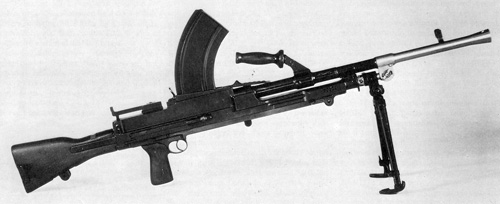
|
|
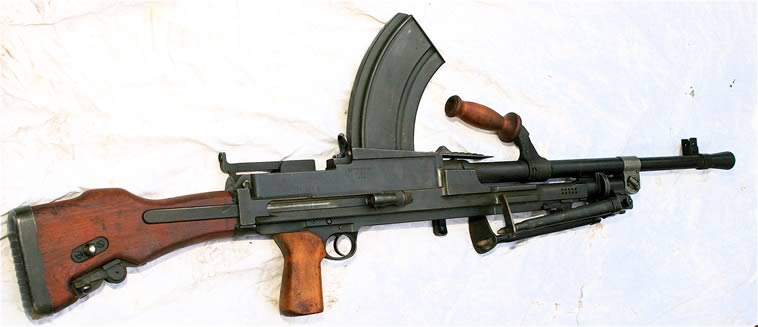
|
|
The British then asked for a .303 caliber
version of the ZB vz.27, with the first example entering testing in
Spring 1931 as the ZGB Model 1. It won out over its competitors, and a
few minor flaws (propellant fouling and extraction problems) were fixed
with the ZGB Model 2 in 1933.
The ZB vz.26 was designed and made originally by Václav Holek at Zbrojovká Praga, but financial problems forced production to be moved to the state-owned Zbrojovká Brno where it was manufactured for the Czech army. After more testing and modifications with the British the .303 ZGB Model 4 Improved was approved for adoption by the British army and a initial 62 weapons were made by Brno. The production licence was signed in May 1935 and the acronym ‘Bren’ was applied to the new gun (‘Br’ for Brno and ‘en’ for Enfield where it was to be made in Britain). It officially became ‘Gun, Machine, Bren, .303-inch Mark I’.
|
|
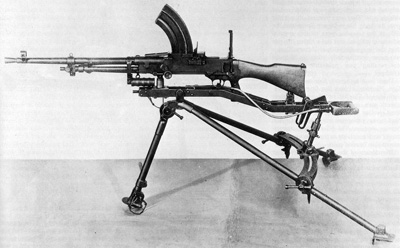
Vickers-Berther on tri-pod
|
The Mk I Bren was an air-cooled light machine-gun, gas operated, locked by a tilting block and fed from a top-mounted detachable box magazine containing thirty rounds.
Some 220,000 Brens were made at the Enfield factory during the war, with a further undetermined number produced by Monotype in Britain, Lithgow in Australia and Inglis in Canada (117,000-125,000).
The Bren was not the only light machine-gun to see service. Despite coming second in trials in 1930-31 the Vickers-Berthier (also air-cooled, gas operated, locked by a tilting block and fed from a top-mounted detachable box magazine) was still under consideration and was adopted by the RAF in 1934 as an observers weapon.
|
|
With adoption of turrets on many new aircraft it was quickly relegated to ground rolls where it found its way into the hands of the LRDG and SAS in the desert where its sturdy construction and high rate of fire were highly prized (Vickers K).
It was also adopted by the Indian Army in 1935 (Gun, Machine, Vickers-Berthier, .303-inch, Indian Mk I), rather than waiting for the development of the Bren in .303 calibre. They were made at Ishapur, India until 1942.
Heavy Machine-guns
The standard HMG used during the war by the British and Empire forces was the Vickers. This simple modification of the Maxim Machine-gun first entered service with the British army in 1912 as the ‘Gun, Machine, Vickers, .303-inch Mark I’.
The water-cooled Vickers was capable of amazing feats of endurance.
|
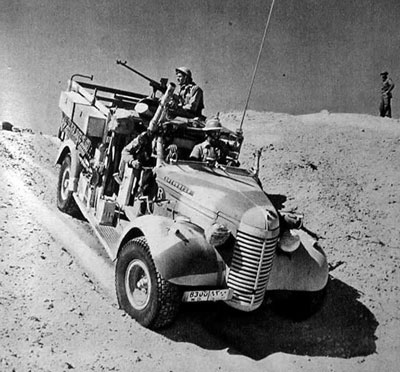 |
|
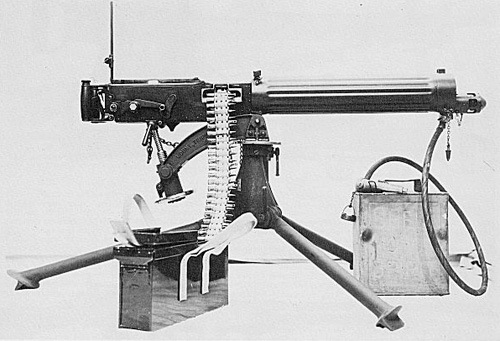
|
In one example in 1916 the Vickers of the 100th Machine-gun company, 100 Infantry Brigade fired nearly 1 million rounds virtually non-stop (with only stops for barrel changes) over a 24-hour period.
They proved such a successful and reliable weapon they remained in service virtually unchanged until 1968. Its rate of fire was about 450rpm, but this could vary with individual weapons.
|
|
Pistols
Of all the weapons used in WWII by the British and Empire forces the pistol would rate as one of the least important, but despite (or maybe because of) this it is the one type of weapon where we see the most variety. The Webley is the weapon that jumps instantly to mind when thinking of British Army service handguns.
The first Webley entered service in 1890 and the model in service at the outbreak of the Second World War was the ‘Pistol, Revolver, Webley, .38 Mk IV’.
|
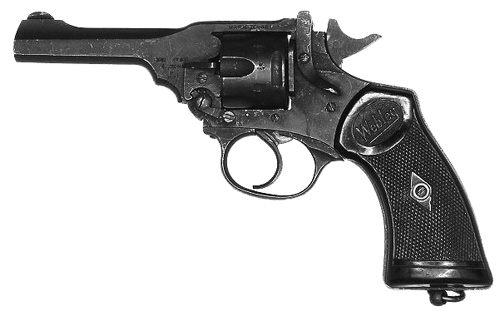
|
|
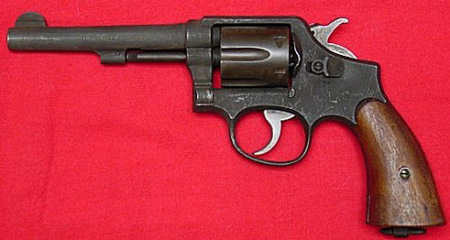
|
The official handgun was the Enfield ‘Pistol, Revolver, .38 No. 2 Mk
1’, which for all intents and purposes was the Webley design.
The .38 calibre Smith & Wesson K200 revolvers were also received from the US (277,125 recorded) as well as .38 Colt revolvers (37,000+). A variety of trade sourced .32, .38 and .45 calibre revolvers were also issued.
Left: Smith & Wesson .38 revolver.
|
|
The only Automatic Pistol to be used in substantial numbers was the FN-Browning GP made by Inglis, Canada. It was officially adopted in 1944 as ‘Pistol, Browning, FN, 9mm, HP, No.2 Mk 1*’. It proved popular with special forces such as the SAS, LRDG and Commandos.
Right: FN-Browning High-Power automatic Pistol.
Mortar, 2" Mk 2
The 2” Mortar was introduced into British service during the 1930’s. At the time a number of different nations had developed light mortars to offer immediate indirect support weapons to the infantry.
|
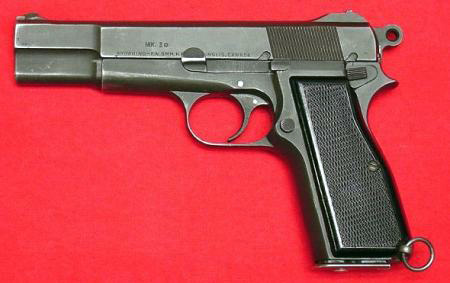
|
|
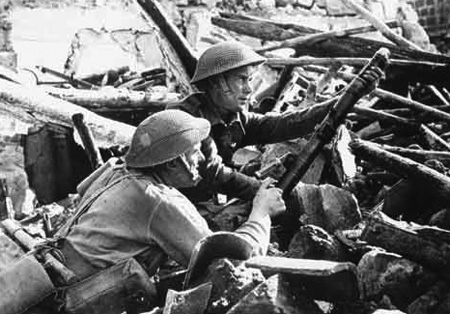
|
The simplest of these was the British 2” (50.8-mm).
The original 2” Mortar featured a large base plate and complex sights, but experience soon led to simplifications in the design.
Subsequent marks carried much smaller base plates and dispensed with sights. Aiming was by eye and judgement, the sole aid being a white line painted on the barrel. One advantage of this system is the ability to fire at very low angles allowing direct fire.
The shortness of the barrel eliminated the option of a drop trigger like on larger mortars so a small trip mechanism was provided at the breech.
|
|
The standard projectile was an HE bomb with an impact fuse in the nose
and a four-finned tail unit with a single primary cartridge. There was
also a smoke bomb. It weighed a mere 4.1kg and was the lightest of the
light mortar designs introduced in the 1930s.
Boys Anti-tank Rifle
0.55 inch Boys Anti Tank Rifle Mark 1
During the 1930s the proliferation of lightly armoured tankettes lead to the development of portable anti-tank weapons. The British developed the “Stanchion Gun” at Enfield and put it into testing in 1934. The calibre was .55 inch, giving the gun a substantial recoil.
In an attempt to reduce it, a muzzle break was fitted and the whole mechanism mounted into a cradle, buffered by a powerful spring. To further reduce the impact on the gunner the butt was thickly padded. The whole rifle was 63.5in (162cm) long, weighing 36 pounds (16.3 kg). The ammunition was fed from a top loading 5-round box magazine. It had a muzzle velocity of 990 metres per second and could puncture up to 21mm of armour.
|
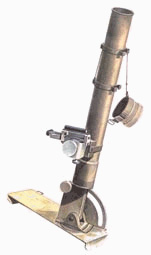
|
|
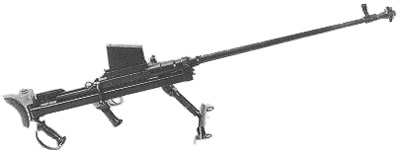
|
Originally called the “Stanchion”, it was renamed to honour the Assistant Superintendent of the Enfield Design Department, Captain H.C. Boys, who had died suddenly during development.
It was used in most theatres of World War II, its ease of portability proving an asset. As well as being issued to infantry it was also fitted into armoured cars.
|
Its greatest success was in North Africa, where it could penetrate the front armour of most Italian tanks.
By 1943 it was being replaced in the field by the PIAT anti-tank weapon.
PIAT and Blacker Bombard… |
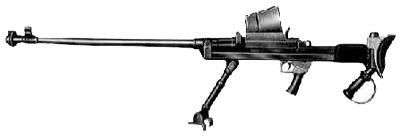
|
Last Updated On Friday, July 30, 2010 by Wayne at Battlefront
|
|
|